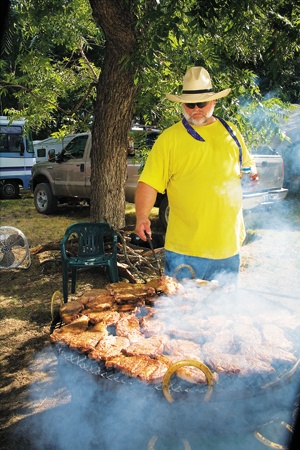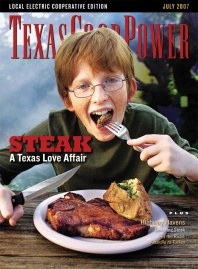The smell is the first thing everyone notices. It’s unmistakable–a combination of wood burning down to coals, sizzling fat and cooking beef. It brings back a thousand memories, all at once and yet still distinct, memories of families and backyards and Boy Scout cookouts and neighborhood barbecues with little kids running all over the place.
“There’s nothing quite like it, is there?” asks Ronnie McIntosh, standing next to a grill in City Park in Hico in Hamilton County, checking the fire every so often. It’s early afternoon on a sweltering July day in 2006—the warmest summer in almost a decade, but McIntosh, who has been at City Park since before 10 a.m., doesn’t seem particularly bothered by the heat. He is there to grill a steak, and that’s important business.
McIntosh, Richard Spradlin, and Andy and Kyle Cook make up one of a dozen or so teams—theirs is called Cook ’n’ Company—competing in the third annual Texas Steak Cookoff. The goal? To grill the perfect steak. “And the only way to do that,” says McIntosh with a laugh, “is to practice, and then practice some more. And then practice even more.”
In this, Goldthwaite’s Cook ’n’ Company, Leggo My Angus of Dallas and all of the cooking contest regulars have something in common with every man and woman who has ever turned on a grill or lit a match under a pile of charcoal. In fact, though grilling steak has a special place in Texas cuisine and in Texas history, what with longhorns and cattle drives, it’s an all-American pastime that dates to the first British colonists (who, it turns out, weren’t averse to having the neighbors over to dine on charbroiled beef). And, no doubt, they faced the same dilemma everyone faces today: How rare is too rare, and can anyone actually eat it well done?
On the Trail
The story is part of American lore, and as lore goes, it’s mostly true. In 1867, an Illinois cattle dealer named Joseph G. McCoy bought steers in Abilene, Kansas, penned them, and then shipped them to the Union Stockyards in Chicago. Over the next 20 years or so, cowboys and trail hands drove 5 million to 10 million cattle out of Texas along the Chisholm Trail and its tributaries, headed for railheads such as Abilene and Dodge City.
And why not? The state had plenty of cattle (by one estimate, there were eight bovines for every person in Texas around the end of the Civil War, most of the cattle wild), and it made lots of economic sense. In 1865, for example, a steer that cost $3 or $4 in Texas might fetch 10 times that amount on the East Coast. Given that return, what was a journey over 700 miles of rough country populated by hostiles, varmints and the like? And, to make the trip even more profitable, the Texas longhorn, for all of its faults as a carrier of the dreaded Texas fever, gained weight during the drive.
Ironically, says Johnny D. Boggs, a writer who specializes in the frontier West, cowboys didn’t eat much beef on the trail. For one thing, the cattle were too expensive, especially for dollar-a-day cowhands. Chuck wagon fare was bacon, biscuits and beans, and maybe something polite society called son-of-a-gun stew, which was made with sweetbreads. Says Boggs: “Even when cowhands reached trail towns like Abilene and Wichita, most preferred fancier dishes than a good steak. Oysters were a favorite.”
On the other hand, the rest of the country loved its beef—and had, for more than 150 years, says James E. McWilliams, who teaches at Texas State University in San Marcos and is the author of Revolution in Eating: The Quest for the Food that Shaped America (Columbia University Press, 2005). Starting with the earliest colonists, eating steak was a sign of prosperity. Poor people ate pork, he says, not only because it was less expensive, but because it was easier to raise. A farmer could turn a pig loose in a swamp and not have to worry about feeding it (and a poacher didn’t even have to worry about who owned the pig). A cow, on the other hand, needed a field to graze, and a field meant land, usually fenced, and that arrangement required a prosperous farmer who could pay for it all.
Head for Pennsylvania
In the middle to late 18th century, the center of the U.S. beef industry was in western Pennsylvania. It had a nationwide reputation, and its beef was exported up and down the Atlantic Coast, from Maine to the West Indies. The meat was salted, smoked or pickled in those pre-refrigeration days, and consumers would cook it over an open flame, usually in a hearth fire. In an 1808 cookbook, The New-England Cookery, author Lucy Emerson says “A roast Potatoe is brought on with roast Beef, a Stake, a Chop, or Fricassee.”
Sounds pretty much like a steak dinner today, doesn’t it?
In fact, says Thomas Schneller, who teaches meat cutting at the Culinary Institute of America in Hyde Park, New York, and is a third-generation butcher, not much has changed about steak since then. Our beef is more tender, but the results are pretty much the same if done correctly. Talk to experts such as Schneller and the Hico contestants, and these rules of thumb become clear:
Choose a cut you like, whether it’s ribeye or T-bone, for there aren’t any right or wrong answers. Bone-in steaks can be more difficult to cook but make for a more impressive presentation.
Marbling—the lines of fat in the beef—matters. That’s because it will melt during cooking, adding flavor and helping keep the meat moist, especially if it’s well done. Look for marbling that’s evenly distributed, and look for dots as opposed to streaks.
High heat is best. The goal is a crusty outside, but a tender and warm inside. A crust, thanks to the miracle of caramelization, adds yet more flavor. It’s even possible to accomplish this feat for steak that’s well done by finishing the meat in a low oven. That way, the outside doesn’t burn, and the inside turns the appropriate shade of brown.
Cooking time depends on the thickness of the cut and how well done it needs to be. The answer here is trial and error; once you figure out how to do it, you’ll always know. Until then, there are no formulas like minute-per-pound. After all, every fire is different. (Though it’s probably better to undercook, since you can finish the steak in the oven or even the microwave.)
And, surprisingly, cook it as well done as you like it, for there are no rules when it comes to that either. Schneller prefers medium rare, but McIntosh likes his medium, and even cooks that way in contests. “The thing with beef,” says Bart Thompson of Leggo My Angus, a medium-rare guy whose team won the Hico competition in 2005, “is that you don’t want to trick it up. Keep it simple. Focus on temperature and time.”
And then enjoy what you cooked.
United Cooperative Services provides electric power for the Hico area. This year’s competition was held in May.
Jeff Siegel, who lives in Dallas, wrote about salsa in our November 2006 issue.


